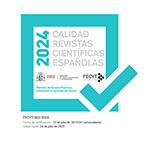Rape myths in the case of 'La Manada'. A critique of the patriarchal public/private divide
Abstract
Introduction. The case of ‘La Manada’ of the SanFermines begins in 2016, with the complaint of a woman for a crime of rape of five men. The media case supposes an unprecedented social, political and media reaction in Spain. The judicial procedure throws the debate about the concepts of consent, violence and intimidation. Objectives. The objective of this article is to provide an analysis of the data on rape in Spain and a framework of feminist interpretation of sexual violence, in order to avoid stereotyped accounts that make it difficult to see this crime as a structural issue. Methodology. The work is based on the function of the rape myths on the AMMSA scale applied to the ‘La Manada’ case. Rape myths in the case of ‘La Manada’. The debate on judicial procedure revolves around the distance between abuse and rape; between whether there was violence or intimidation. Secondary victimization occurs by not believing the victim's account; by hiring a detective to follow her life and by questioning her behaviour before the crime; as well as for the use of recording of the criminal act. Conclusions. Group rapes such as ‘La Manada’ provide a story in which, implicitly, the crime of rape is related to public space and unknown men. However, it has been found that homes are the first space in which rapes occur and the first victims in Spain are children (0-17 years old). Rape must be conceptualized as a structural issue; and put an end to the antagonistic distance between public and private space that still hides a historical patriarchal mandate: the home is the safe space for women.
Downloads
Article download
License
In order to support the global exchange of knowledge, the journal Investigaciones Feministas is allowing unrestricted access to its content as from its publication in this electronic edition, and as such it is an open-access journal. The originals published in this journal are the property of the Complutense University of Madrid and any reproduction thereof in full or in part must cite the source. All content is distributed under a Creative Commons Attribution 4.0 use and distribution licence (CC BY 4.0). This circumstance must be expressly stated in these terms where necessary. You can view the summary and the complete legal text of the licence.











